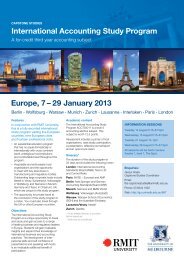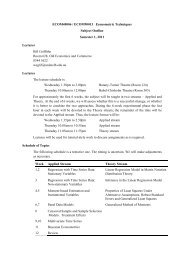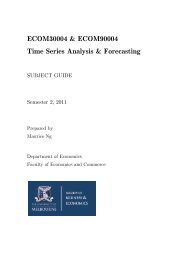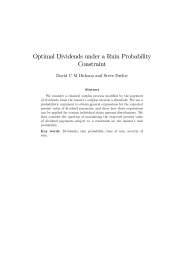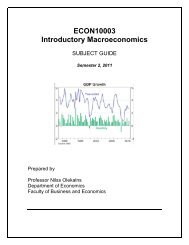2 Analysis <strong>of</strong> ConstraintsIn order to solve for the optimal bailout, it is necessary to describe the constraints within eachcontinuation game, working backwards in sequence. We begin with the restart stage, thenmove back to the initial project stage, <strong>and</strong> finally describe the optimal design <strong>of</strong> bailout policy.2.1 Restarted Projects (Period 2)Consider the players’ optimal strategy at time 2 for a project that has failed at time 1, supposingfirst that the firm has restarted the project (so that investment I 2 <strong>and</strong> bailout g are alreadysunk). The firm <strong>of</strong>fers the manager a contract paying w 2 in the event that the project succeedsat time 2, <strong>and</strong> zero otherwise. (The continuation game is the same if the period-1 manager isreplaced.) The manager now expects to receive m 2 ≡ e 2·w 2 − c·e 2 /2. Her pay<strong>of</strong>f-maximizing2effort is e ∗( w 2 2 ) = w 2 /c, which results in expected continuation pr<strong>of</strong>its for the firm <strong>of</strong> π 2 =e ∗( w 2 2 )·(R − T 2 − w 2 ). Assuming the firm operates, it optimally pays a success-contingent wage<strong>of</strong> w ∗ = (R − T 2 2)/2. This induces a managerial effort level <strong>of</strong> 13e ∗ = R − T 2.22·cThe continuation value <strong>of</strong> a restarted project for the manager is therefore 2m ∗ ( g, T 2 2 ) = e 2·w∗ ∗ − c·e∗2 2 R −22 = T2.8·cThe firm’s expected time 2 pr<strong>of</strong>its (now inclusive <strong>of</strong> bailout subvention <strong>and</strong> restart costs) areπ ∗ ( g, T 2 2 ) = e2· R 2R − T2 ∗ − T 2 − w2 ∗ + g − I2 = + g − I 2 .4·cSequential rationality requires that the firm restarts if <strong>and</strong> only if its expected pr<strong>of</strong>its arenonnegative. The firm’s optimal restart strategy isρ ∗ = IN if π ∗( g, T 2 2 ) ≥ 0 ,2OUT otherwise.Larger governmental subsidies push the firm toward restarting, while taxes on successfulrestarts push the firm towards ab<strong>and</strong>oning.Finally, the government’s interim pay<strong>of</strong>f at this stage is⎧⎨ R−T2 3·R+4·S+T2sv ∗ ( g, T 2·c ·− I42 if ρ ∗2 2 ) == 2 IN⎩0 otherwise.13 Even when T 2 = 0, managerial effort is below first-best, e FB2= (R + S)/c. The government has neither theability to set wages nor the ability to coerce the manager into providing first-best effort. (It can also not pay thefirm negative taxes to increase the incentives.) Thus, governmental intervention is not able to achieve first-best.12
As long as the firm reinvests, sv ∗ 2 ( g, T 2 ) is invariant in g, <strong>and</strong> strictly decreasing in T 2 . Moreover,Bayesian perfection also requires sequential rationality from the government, so that g, T 2 , F G must remain optimal at time 2. This leads to the following theorem:Theorem 1 The optimal bailout policy sets T ∗ = 0. Moreover, the optimal bailout pays a positive2subsidy g ∗ only if R 2 /(4·c) − I 2 < 0, <strong>and</strong> sets g ∗ = I 2 − R 2 /(4·c), so that the firm earns zerocontinuation rents, i.e., π ∗( 2 g∗ , T ∗ ) = 0. 2(All lemmas <strong>and</strong> theorems are proven in the Appendix.) Although it is surprising at first thatT 2 = 0, the intuition is straightforward. Any marginal increase in T 2 inefficiently reducesmanagerial effort. As T 2 increases, the tax distortion causes firm pr<strong>of</strong>its to fall even fasterthan tax revenues rise, sharpening the government’s balance budget constraint. Consequently,the government can do no better than to drive T 2 to zero, <strong>and</strong> instead to finance any bailoutentirely by time 1 tax revenues (<strong>and</strong> paying out the residual bailout surplus, if any, as a cashgrant to the firm or other members <strong>of</strong> society). In contrast, although T 1 also distorts first-periodeffort, it does not necessarily do so in a self-defeating way, because T 1 is not capitalized intothe required bailout subsidy. 14This insight in turn provides the basis for the second part <strong>of</strong> Theorem 1. <strong>Optimal</strong> bailoutsmust raise revenue solely from T 1 , but the distortions caused by T 1 > 0 are socially costly aswell. Any optimal bailout should avoid “overfunding” the minimal subsidy needed to inducecontinuation. Consequently, an optimal bailout must set both g <strong>and</strong> T 1 to the lowest amountthat prevents closing. It also implies that the optimal policy does not subsidize firms that wouldreinvest without government intervention (i.e., those for whom π ∗ 2 ( 0, 0 ) = R2 /(4·c) − I 2 ≥ 0).Therefore, Theorem 1 also states that when the optimal bailout involves a positive transfer, itsets g to be I 2 − R 2 /(4·c), just enough to induce reinvestment but leaving the existing ownerswith zero continuation pr<strong>of</strong>its. (In practice, this would <strong>of</strong>ten be done through expropriation ina formal Chapter 11 bankruptcy.)A direct implication <strong>of</strong> Theorem 1 is that any feasible bailout funded entirely by T 2 (withT 1 = 0) is worse than a government non-intervention policy. This is because any bailout thatis funded entirely by T 2 revenues can only bail out firms that would restart on their own, i.e.,without any assistance (or tax) from the government.Collecting results from the analysis <strong>of</strong> time 2, interim incentive <strong>and</strong> participation constraintsreduce to the following conditions:w ∗ = R 22 , e∗ = R 0 if π∗22·c , T ∗ = 0, 2 g∗ 2=( 0, 0 ) ≥ 0 −π 2 ( 0, 0 ) if π ∗( 0, 0 ) < 0 , ρ∗ = IN if π ∗( 2 g∗ , T ∗ ) ≥ 0 22OUT otherwise2where π 2 ( 0, 0 ) = R 2 /(4·c) − I 2 . We will impose these conditions in the analysis <strong>of</strong> the time 1behavior that now follows.,14 This result contrasts with the st<strong>and</strong>ard “Ramsey pricing” intuition in optimal tax literature, where the taxes ontwo activities (here time 1 <strong>and</strong> 2 production) would be set to equilibrate marginal efficiency costs.13



